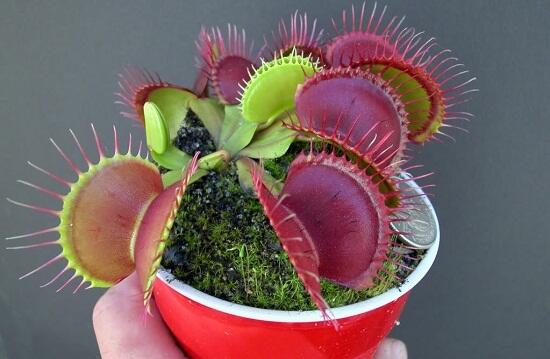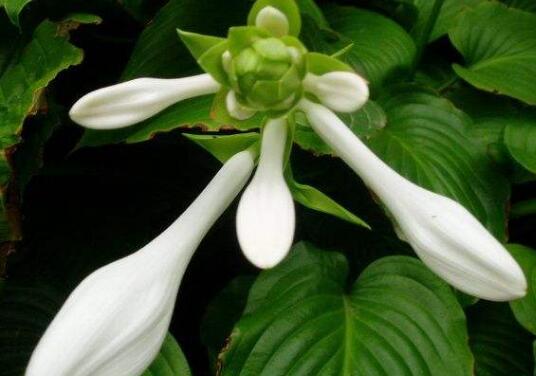How to water the flytrap, the maintenance skills of the flycatcher waist water method / two kinds of wild release and stuffy culture.
Flytrap is a kind of plant that can repel mosquitoes. Keeping it indoors can not only eliminate flies in the home, but also purify the air. But it is not easy to raise the flytrap well, and the most important thing to pay attention to is watering. How to water the flytrap? The following is the flycatcher waist water maintenance skills and fertilization methods, follow the editor to have a look.
First, how to water the flytrap and waist water

Unlike other indoor potted plants, watering the flytrap is not directly watered with a kettle, but with waist water, which has been mentioned in the flytrap culture method. However, the waist water method has two problems, one is that the roots are easy to rot at high temperature in summer, and the other is the accumulation of minerals over a long time. In order to solve these two problems, let's take a look at the maintenance techniques of fly-catching grass waist water method.
Maintenance skills of fly-catching grass waist water method
Before understanding the maintenance techniques of flycatcher waist water, it is necessary for us to know the growth habits of flycatcher. It is understood that the fly-catching prairie grows in swamps and is often exposed to strong sunshine for a long time. At this time, the temperature of the ground will continue to rise, and a large amount of water will evaporate from the ground to the ground, but at the same time, because the underground temperature is lower than the ground, the cool moisture will take away the heat from the roots of the plant.
After the heat is taken away, the phenomenon of rotting roots of the fly-trapping grass will not appear. After understanding this habit of the flytrap, the flycatcher waist water method needs to make use of this point, the method is to properly adjust the cultivation medium, we can choose the medium of water retention, air permeability, and improve heat dissipation, as follows:
1. Wild release medium
Place coarse-grained phytolith or foam blocks and sponge blocks at the 1pm 4 of the basin floor to keep ventilated while absorbing moisture. 40% medium-and fine-grained red jade soil, or 20% peat soil mixed with red jade soil, or 100% pure water moss can be added to the upper layer, which is helpful to lock in moisture and maintain humidity.
Because when released in the field, the water volatilizes very quickly, you can add 60% of medium-and fine-grained mixed gold stone or 30% of medium-and fine-grained mixed gold stone + 30% medium-grained imperial stone, waist water 1 amp 4 pots or so. If the summer temperature is above 30 ℃, it needs to be shaded by 50%, which is exposed to soft scattered light.
2. Stuffy medium
Place coarse-grained phytolith or foam block at 1x4 at the bottom of the basin to absorb moisture while maintaining ventilation and ventilation. The upper layer can use 100% pure water moss or 40% medium or fine grained red jade soil or 20% peat soil mixed with 20% red jade soil to lock in moisture and maintain humidity.
When released in the field, the water volatilizes very quickly. 60% of the medium and fine grain mixed gold stone or 30% of the medium and fine grain mixed gold stone plus 30% medium grain imperial stone can be added to it, and the waist water is less than 4 pots. Similarly, if the summer temperature exceeds 30 ℃, do not cover the container, keep the top of the container ventilated, shade 50%, and place it in a soft and bright place of scattered light.
There is another reason why the flytrap is watered with waist water: professional farmers have tens of thousands of pots in a flower shed, and how long do they have to be watered one by one, so they are all raised with waist water. And after reading the above, I believe we all know something about the maintenance skills of fly-catching grass waist water, and you can also raise it in this way.
Maintenance skills of fly-catching grass waist water method
The wild release of flytrap
Place coarse-grained phytolith or foam blocks and sponge blocks at the 1pm 4 of the basin floor to keep ventilated while absorbing moisture. 40% medium-and fine-grained red jade soil, or 20% peat soil mixed with red jade soil, or 100% pure water moss can be added to the upper layer, which is helpful to lock in moisture and maintain humidity. Because when released in the field, the water volatilizes very quickly, you can add 60% of medium-and fine-grained mixed gold stone or 30% of medium-and fine-grained mixed gold stone + 30% medium-grained imperial stone, waist water 1 amp 4 pots or so. If the summer temperature is above 30 ℃, it needs to be shaded by 50%, which is exposed to soft scattered light.
Stuffy cultivation of flytrap
Place coarse-grained phytolith or foam block at 1x4 at the bottom of the basin to absorb moisture while maintaining ventilation and ventilation. The upper layer can use 100% pure water moss or 40% medium or fine grained red jade soil or 20% peat soil mixed with 20% red jade soil to lock in moisture and maintain humidity. When released in the field, the water volatilizes very quickly. 60% of the medium and fine grain mixed gold stone or 30% of the medium and fine grain mixed gold stone plus 30% medium grain imperial stone can be added to it, and the waist water is less than 4 pots. Similarly, if the summer temperature exceeds 30 ℃, do not cover the container, keep the top of the container ventilated, shade 50%, and place it in a soft and bright place of scattered light.
Maintenance of fly-catching grass by waist water method
Flycatcher waist water method cultivation is now used by many flower friends, when using waist water method maintenance, you only need to pay special attention to the high temperature in summer, the waist water chassis will cause the water temperature of water storage to rise rapidly because of the strong sunshine, such as boiling hot water absorbed through the basin bottom to the surface of the medium to evaporate, moisture can not take away the heat from the root of the plant, which is the main cause of "rotten root".
The flytrap, which lives in nature, is often subjected to long periods of intense sunshine. Although the temperature of the ground does not rise, a large amount of water evaporates from the ground to the ground. At the same time, because the underground temperature is lower than that of the ground, the cool moisture will take away the heat from the roots of the plant.
After understanding the laws of nature, as long as the appropriate adjustment of the cultivation medium. Choose the medium that can retain water, permeate air and improve heat dissipation, as follows:
1. Wild release: coarse-grained plant stones or foam blocks are placed at the bottom of the basin, sponge blocks (absorb moisture while maintaining ventilation) the upper layer can use 1/4 pure water moss or 40% medium or fine-grained red jade soil or 20% peat soil mixed with 20% red jade soil (lock in moisture and maintain humidity. Due to the rapid volatilization of water during field release, + 1/4 of medium and fine mixed phytolith or 30% of medium and fine mixed phytolith + 30% of medium emperor stone (providing excessive moisture after mixing red jade soil, so that the upper layer of the mixed medium still has a good air permeability) 1/4 pots of waist water. "if the summer temperature is above 30C, it should be shaded or placed in a soft and bright scattered light."
2. Stuffy: "coarse-grained phytolith or foam blocks are placed at the bottom of the basin (absorbing moisture while maintaining ventilation). The upper layer can use 1/4 pure water moss or 40% medium or fine grained red jade soil or 20% peat soil mixed with 20% red jade soil (lock in moisture and maintain humidity. Due to the rapid volatilization of water when released in the field, + 60% medium-and fine-grained mixed phytolith or 30% mixed medium-fine phytolith + 30% medium-grained imperial stone (providing excessive water after mixing red jade soil, so that the upper layer of the mixed medium, still maintain a good air permeability) below 1/4 pots of waist water. " If the summer temperature is more than 30 degrees C, the stuffy container should not be covered and should not exceed 10 centimeters above the plant (keep the top of the container ventilated), shade 50% or place in soft and bright scattered light.
- Prev

How to raise fly traps with big clips, deep light in flowerpots, sufficient watering and fertilizing.
Every summer comes, in order to avoid the trouble of flies and mosquitoes, people will choose to raise a pot of flytrap at home, because it is a mosquito repellent plant. It is understood that the flytrap clip can catch flies, mosquitoes and other small insects, its clamp is large, the more powerful the trap, then how does the flytrap keep the clamp big? To this
- Next

How to raise the jade hairpin flowers, the culture methods and precautions / avoid bright light
The jade hairpin flower is a kind of highly ornamental plant, which can be seen in many gardens in our country, and many people are breeding in our country, but there are many places that need to be paid attention to in the process of breeding, so how to raise the jade hairpin flower? What are the culture methods and matters needing attention of hairpin flower?
Related
- Fuxing push coffee new agricultural production and marketing class: lack of small-scale processing plants
- Jujube rice field leisure farm deep ploughing Yilan for five years to create a space for organic food and play
- Nongyu Farm-A trial of organic papaya for brave women with advanced technology
- Four points for attention in the prevention and control of diseases and insect pests of edible fungi
- How to add nutrient solution to Edible Fungi
- Is there any good way to control edible fungus mites?
- Open Inoculation Technology of Edible Fungi
- Is there any clever way to use fertilizer for edible fungus in winter?
- What agents are used to kill the pathogens of edible fungi in the mushroom shed?
- Rapid drying of Edible Fungi

